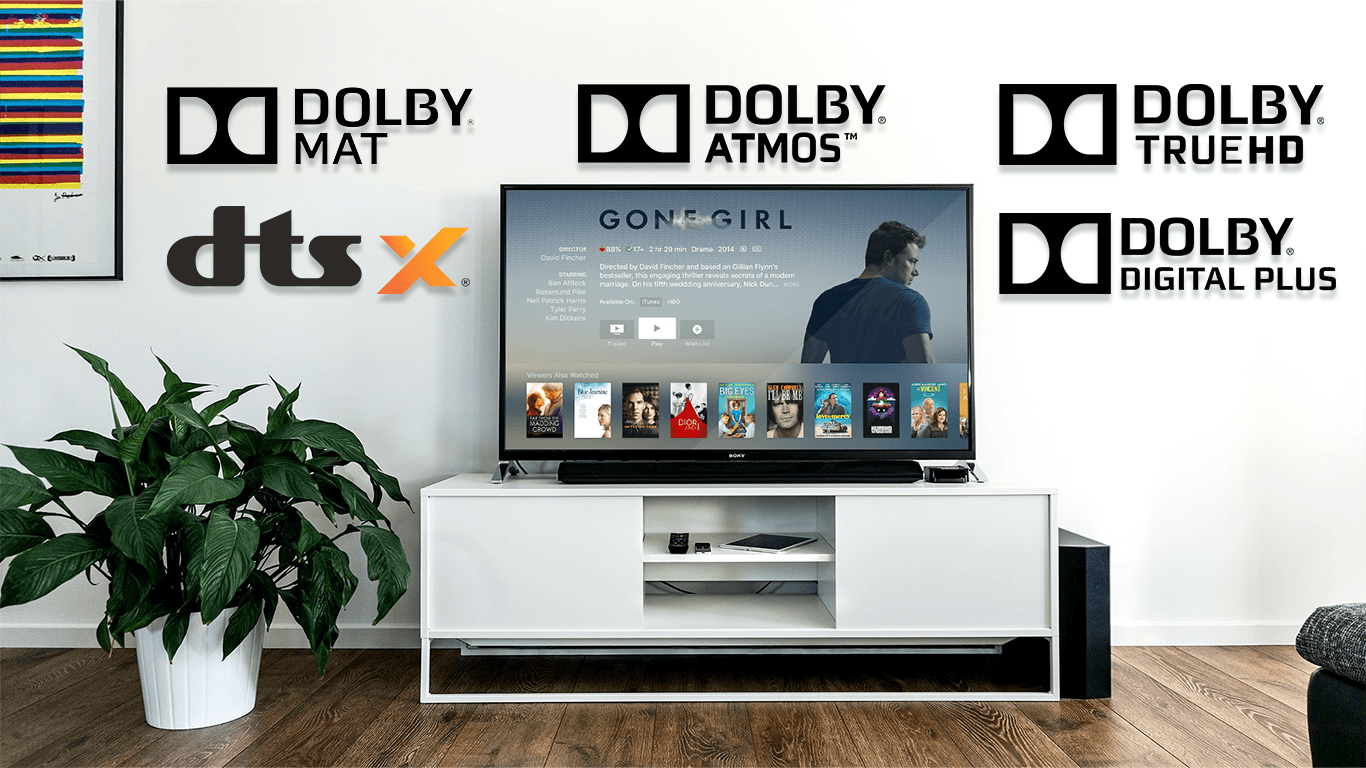HDMI audio formats
The introduction of HDMI opened up great possibilities for sound. HDMI transmits many audio formats over the same interface - but not at the same time. The devices must agree on a format, for example Dolby Digital. The HDMI handshake ensures that a device receives the best and most compatible sound. At least that is the plan. This works well when an HDMI source and an HDMI sink are connected. But the difficulties begin when another HDMI sink (TV or sound system) is added and these devices support different audio and video formats. More on this here .
The special thing about HDMI is that it can transport very different audio formats together with the video signal. Several formats can be included in the medium (as a Blu-ray disc or data stream). But HDMI only outputs one of these formats. Blu-ray discs often offer 3 or more formats, from stereo to 3D high-definition sound. Computer games, streaming services and television also offer a selection.
Dolby Digital
The Dolby Digital (AC-3) codec is widely used as an audio standard for DVDs and digital television. Dolby Digital supports various audio channel configurations, but the most common are 5.1 channel and stereo. The notation "5.1" refers to the number of audio channels. This corresponds to the number of possible speakers that receive specific sound data. With 5.1 there are 5 speakers (left, right, center, rear left, rear right) plus a subwoofer for the bass. Dolby Digital audio with 5.1 channels is usually encoded with bit rates between 384 and 640 kbps, while stereo Dolby Digital audio (2.0) is encoded with 192 kbps.
Dolby Digital Plus
Dolby Digital Plus (E-AC-3) offers up to twice the efficiency of Dolby Digital and offers new features such as 7.1-channel audio and support for Dolby Atmos (more on that later). Streaming and broadcast services often use Dolby Digital Plus to deliver surround sound audio at lower bit rates. 5.1-channel audio in Dolby Digital Plus is typically encoded at bit rates between 192 and 256 kbps, while stereo audio in Dolby Digital Plus uses a bit rate between 96 and 128 kbps. Dolby Digital Plus bit streams are not backwards compatible with Dolby Digital decoders. But Dolby Digital Plus decoders can decode Dolby Digital bit streams.
The theoretical maximum is 6144 kbps. Netflix uses up to 640 kbps for 5.1 sound and up to 768 kbps for Dolby Atmos. The data rate is dynamic or adaptive. Therefore, it decreases in quiet scenes.
Dolby TrueHD
Many HD and UHD Blu-ray discs use the Dolby TrueHD audio codec, also known as MLP. Dolby TrueHD supports up to 24 bits of audio and sample rates from 44.1 kHz to 192 kHz. Dolby TrueHD uses up to 7.1 channels of audio as well as Dolby Atmos. Because Dolby TrueHD is a lossless audio codec, the data rate is variable. For example, Dolby TrueHD bit rates with Dolby Atmos at 48 kHz average around 6,000 kbps, with peak data rates of up to 18,000 kbps for high sample rate content.
What about Dolby Atmos?
Recently, there is more content and devices that support Dolby Atmos . But Dolby Atmos is not a codec! It is an immersive audio format that has multiple audio codecs including Dolby Digital Plus and Dolby TrueHD (but not Dolby Digital). Blu-ray discs deliver Dolby Atmos with Dolby TrueHD (with Dolby Digital Plus as an available alternative), and broadcast and streaming services deliver Dolby Atmos with Dolby Digital Plus. To ensure compatibility with existing devices, Dolby Atmos is implemented in these codecs as a backwards compatible extension. Dolby Atmos data is hidden in the bitstream and can be decoded using a Dolby Atmos-compatible A/V receiver, soundbar or TV. Only this end device creates the separate channels for all speakers. Non-Dolby Atmos-compatible devices decode a 5.1-channel or 7.1-channel version from the Dolby Digital Plus or Dolby TrueHD bitstreams. There is new HDMI signaling whereby an HDMI sink indicates support for Dolby Atmos.
Dolby MAT
Media players such as Apple TV 4K and Xbox One S/X decode a Dolby Digital Plus or Dolby TrueHD audio track, possibly enrich it with their own sounds and encode them again. The sound system then receives up to 8 PCM channels.
Advantage: The audio track can be overlaid with system sounds from the player (“Siri”). And the processing in the sound system can be faster, which is important when gaming.
Disadvantage: The audio signal requires a lot of bandwidth without improving the quality. Output via HDMI-ARC is not possible. eARC on the TV or a direct HDMI connection to the sound system is required. Some AV receivers then only show "multichannel PCM" on their display, no longer the original codec. The conversion can be very fast, but still noticeable. Many Xbox users report a delay in audio output when Atmos is activated on the Xbox.
These PCM channels can contain metadata for Dolby Atmos. This is why this form of transmission is called “Dolby Metadata-enhanced Audio Transmission” – Dolby MAT for short.

DTS
Digital Theater Systems ( DTS ) is a multi-channel sound system that was designed for use in cinemas, laser discs and DVDs. Like Dolby Digital, it transmits up to 5.1 channels in a compressed format. The data rate is typically 754 kbps. It cannot be streamed and can be found on Blu-ray discs and "backup copies" of them.
DTS-HD
DTS High Definition (DTS-HD for short) is a further development of the DTS sound system and is often used in Blu-Ray discs. It consists of the lossless DTS-HD Master Audio (maximum 24,500 kbps) and the lossy DTS-HD High Resolution Audio (maximum 6,000 kbps).
DTS:X
DTS offers a technology called DTS:X that distributes audio objects to the speakers in real time. As with Dolby Atmos, the sound system calculates countless objects from the 7.1 audio channels. DTS:X is transported via the two DTS-HD audio formats.
Other 3D audio formats
Auro 3D a channel-based audio system. This means that the optimal speaker setup is predetermined. It can include 9.1, 10.1, or 13.1 speakers. Auro 3D is included as an additional soundtrack on some Blu-Rays and in movies.
Tempest is the 3D audio format of the Playstation 5 and aims to compete with Dolby Atmos. Using psycho-acoustic processes , Tempest outputs 3D sound via stereo headphones and gaming TVs.

HDMI and HDMI-ARC
All of these formats are now supported in the forward HDMI connection between a source device and a sink device. So from the HDMI output to the HDMI input, just like the video signal. A television also delivers sound without an external source, e.g. from the receiver for cable TV or satellite or smart TV apps. The HDMI return channel HDMI-ARC is used to transmit such audio data. The television transmits the sound from an HDMI input to the HDMI output of the sound system. For a return path HDMI connection, e.g. from the television to the soundbar, there are 2 protocols: ARC (Audio Return Channel) and eARC (enhanced Audio Return Channel). Only the new eARC connection supports all audio formats.
S/PDIF
TVs or HDMI sources can also output the sound digitally via S/PDIF. S/PDIF (Sony/Philips Digital Interconnect Format) allows digital audio signals to be sent via an optical or coaxial connection. The optical connection via fiber optic cables with Toslink connectors is the most common. It has always been a popular type of connection for transmitting digital audio signals to both soundbars and A/V receivers. S/PDIF supports two channels of uncompressed PCM audio or compressed audio in Dolby Digital 2.0 and 5.1 (AC3) as well as DTS. S/PDIF supports not Dolby Digital Plus, Dolby TrueHD or DTS-HD. S/PDIF does not have enough bandwidth to transport the high bit rates. The conductor is made of plastic, not fiberglass.


